
PERU INFO
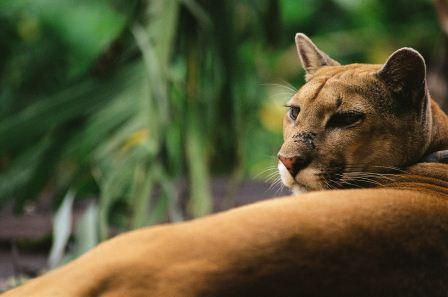

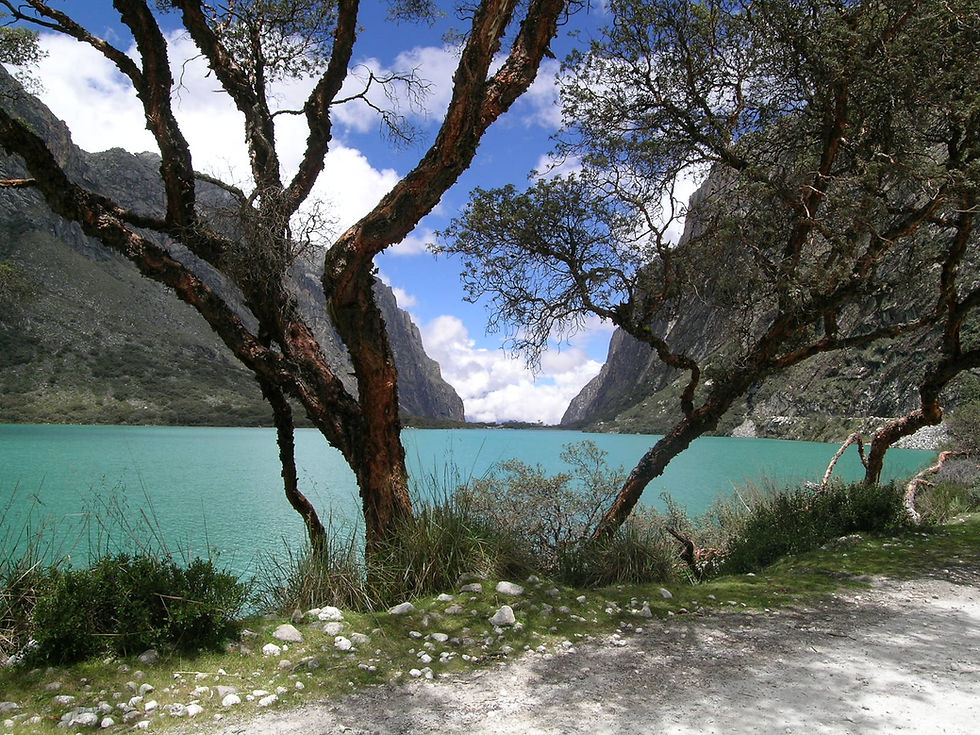

Unusual Peru
Peru anecdotes
The Kon-Tiki expedition
Several chroniclers of the period of the conquest as Pedro Sarmiento de Gamboa, wrote that the Inca Tupac Yupanqui (son of Pachacutec), sailed with 20,000 men from the current coast of Ecuador.
Incas would have reached Nina Chumbi and Huaga Chumbi islands (current Galapagos islands) 972 km (604 mi) from the coast and then to Tuamotu islands (now French Polynesia) at a distance of 6,980 km (4.340 mi) or 3.770 nautical miles.
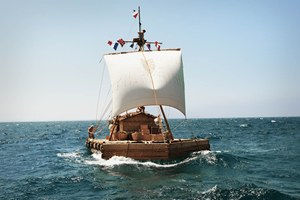
The Norwegian explorer and anthropologist Thor Heyerdahl, wanted to prove that people from the South American Andes could have settled Polynesia and in pre-Columbian times. He organized an expedition in 1947, left the port of Callao in Lima with a raft composed of balsa tree trunks, using only materials available to those people at the time and crossed the Pacific Ocean with five assistants, along nearly 7,000 km (4,300 mi) in 101 days to the Raoia atoll in the Tuamotu group. Most anthropologists have disputed his theory, but remains the writings of the conquerors.
Amazon river
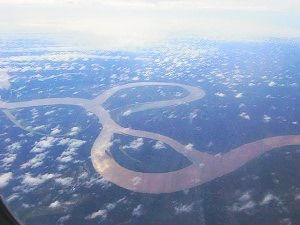
Two international scientific expeditions, one led by the Polish explorer Palkiewicz in 1996 and another by the Peruvian and Brazilian Insitutes of Geography in 2006, were able to determine precisely the source of the Amazon river on a snowcapped called Quehuisha (5,150 m / 16,892 ft) into the Quebrada Apacheta near the Nevado Misti (Colca Canyon - Arequipa, southeast of Lima).
These scientists made new calculations and with 7,062 km (4,388 mi) exceeds 300 km (185 mi) the Nile (6,756 km / 4,198 mi) previously considered the longest in the world. The Amazon also has the record for the highest discharge with an average of 209,000 m3 / sec (7,400,000 cu ft/s), equivalent to the 7 other rivers with more discharge in the world together (Congo, Ganges, Orinoco, Madeira, Yangtze, Negro and Rio de la Plata). The Amazon is responsible for about 20% of the Earth's fresh water entering the ocean.
As most of the rivers in Peru, it changes its name in each region that crosses. So is called successively Apurimac, Ene, Tambo, Ucayali and finally takes the name of Amazon where unite with the Marañon river near the city of Iquitos in northern Peru.
The Perricholi
María Micaela Villegas y Hurtado (1748 - 1819), known as La Perricholi, was a celebrated entertainer and the famous mistress of Manuel de Amat y Juniet, Viceroy of Peru from 1761 to 1776, who built several spectacular buildings in his honor as la Alameda de los Descalzos and the Paseo de Aguas.
The nickname is nothing romantic, the high society who did not much appreciate this ambitious, whimsical and provocative mestiza, called she "Perra Chola" (indian bitch), transformed by the less vulgar term "Perri choli" to humiliate her.
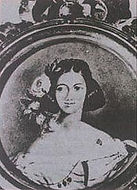
His story inspired many writers, films and theater plays like the novel of the French Prosper Mérimée "le Carosse du Saint-Sacrement" (the coach of the Holy Sacrament), of with the famous opéra bouffe "La Périchole" by Jacques Offenbach in 1868 and the film "Le carrosse d'or" (the Golden Coach) by Jean Renoir in 1953, the novel of the American Thornton Wilder "The bridge of San Luis Rey," which won Pulitzer prize in 1928 and which three films have been based, the last one in 2004 directed by Mary McGuckian starring Robert De Niro and Geraldine Chaplin.
Saint Rose of Lima
(1586 - 1617) Isabel Fores y de Oliva is the first and most important American saint, patroness of Lima, of Peru, of the New World (Americas), of the Philippines, of the National Police of Peru and of the armed forces of Argentine and Paraguay. Devoto from his youth, she had dedicated his life to helping others. In 1615, a fleet of Dutch corsairs was preparing to attack Lima causing the leak of many people. Therefore, salvation of the city is due to the miracle of the mysterious death of Dutch captain because of Rose's prayers.
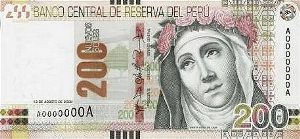
Now the saint appears in the banknote S / .200, is celebrated in many countries on 30 August (23 in Spain) declared public holiday in Peru, in which the faithful are to deposit their wishes written on a well located in the sanctuary of Santa Rosa de Lima.
The Tapadas
The Tapadas Limeñas (covered women from Lima) were veiled ladies from the sixteenth to the nineteenth century and became, paradoxically, a symbol of the liberation of women in the world as told Flora Tristan, a French-Peruvian feminist: veiled but free to walk alone, causing religious fury in this time.
Behavior initially adopted by mestizo women of the high society who wore the "saya", a long skirt outlining the hips unlike the wide dresses of the time and silk shawl that covered the head and the face except one eye. Thus, they escaped the vigilance of men, hiding her identity, race, age and allowed many liberties, such as flirting in total anonymity, causing sometimes confusions. So, a man could flirt his own wife, mother, daughter or cousin unknowingly. Often the church tried unsuccessfully to ban this practice and the Viceroyalty just tolerated it for 3 centuries.
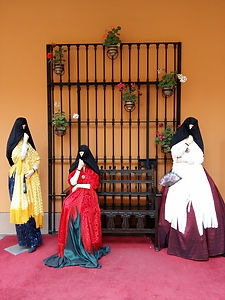
The rewards of Peruvian folklore
Two dances of the Peruvian Andes have been designated by UNESCO intangible cultural heritage in 2010.
La Danza de las Tijeras
Th scissors dance consists of two or more dancers in colorful costumes doing impressive acrobatic moves in turns, challenging each other testing their skills and continually manipulating two metal plates like scissors.
This dance seems to have inspired the break-dance & hip-hop that has a great similarity with Peruvian dance.
La Huaconada
A group of men called huacones, masquerade with masks of prominent noses evoking the beak of the condor, dance, jump and "punish" the adulterers and thieves with whips.
Fiesta de la Candelaria
This festival in honor of the Virgin of Candelaria, patron saint of the city of Puno, has been declared Intangible Cultural Heritage in November 2014 by UNESCO. The festival takes place over two weeks in late January and early February.
The festival involve 170 groups of 40,000 dancers, 5,000 musicians from across the region and indirectly 25,000 people, combining religious rituals with native dances and crafts of the cultures of the Quechua, Aymara and of the mestizos of the Altiplano. The colorful spectacle featuring "costume dances" with extravagant masks.
It stands as one of the three largest festivals in South America with the Carnival in Rio de Janeiro and the Carnival in Oruro in Bolivia.
Peruvian waltz
The "vals criollo" is an adaptation of the European waltz, accompanied by guitar and cajón (wooden box). Well known throughout Latin America between 30 and 50, the French singer Edith Piaf made famous the Peruvian waltz with the song "The Crowd" in French called "La Foule".
Ima Sumac
“How Beautiful!” in quechua
His real name was Zoila Augusta Emperatriz Chavarri del Castillo, claimed that she was directly descended from Inca Atahualpa, confirmed by the Peruvian government in 1946.
Peruvian soprano, she became an international success in the 50s based on her extraordinarily vocal range, of slightly over four octaves from E2 to B♭7, from coloratura soprano to baritone. She was the only one who managed to triple coloratura which is the chirping of birds.
Ima Sumac has his name inlaid in the Hollywood Walk of Fame.
Juan Diego Flórez
Operatic tenor internationally recognized, is one of the best opera singers in the world, named as his successor by Luciano Pavarotti and considered by Placido Domingo as "the greatest light-lyric tenor of all time".
Lord of Sipan
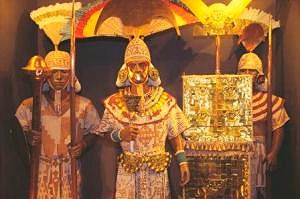
Ubicated near the city of Chiclayo northern coast of Peru, the tomb of the Lord of Sipan is considered the most important of America and is often compared to that of Tutankhamun in Egypt for the riches it contains.
The Lord of Sipan was a leader of the Mochica civilization and was buried in 250 AD with 8 other people, 2 llamas, one dog, numerous ceramics and more than 400 items of gold, silver, copper and semi-precious stones.
The guano era
The story begins in 1845 with the first presidency of Ramón Castilla restoring political stability in the country after 20 years of anarchy and economic paralysis after independence.
The guano, Quechua word meaning "shorebirds excrements", is a natural fertilizer rich in nitrogen and phosphorus.
The organic matter that contain improves soil structure and is considered the best natural fertilizer in the world.
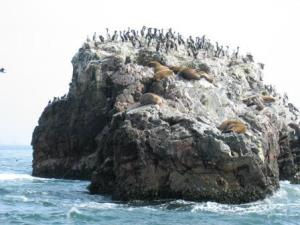
The Pacific coast of Peru is the richest in the world for its marine wildlife thanks to the cold Humboldt current, that flows north from Antarctica, favoring the development of plankton feeding the fishes, a paradise for birds, seals, etc. about 25 islands near Chincha and Paracas (200 km / 125 mi south of Lima) were covered with a layer of guano, up to 70 meters (230 ft) thick and due to high demand in North America and Europe for agricultural development, Peru began a period of prosperity that lasted 30 years.
The bird population at this time was estimated at 28 million and 300,000 tons of guano were exported annually. Today, because of intensive fishing of the Peruvian anchoveta (family of anchovies) to make fishmeal (second source of income of the country), just 5 million birds have recorded and export of guano does not exceed 20,000 tons.
This sudden mismanaged wealth only benefited the capital, while the rest of the country fell totally forgotten.
Until Spain wanted to take this treasure demanding payment of Peruvian debts stemming from the War of Independence and trying to seize the islands in 1864. Peru declared the war to Spain and managed to defeat the Spanish fleet.
The governments of that time did not take advantage of this wealth to invest in productive industry and development of education.
The country began to import everything he needed from Europe, ruining its own production and its already weak industry.
With the depletion of guano, Peru goes bankrupt, too weak to face the Pacific War in 1879, losing it with its ally Bolivia against Chile.
Amazon rubber boom
After the discovery of vulcanization by Charles Goodyear and tires by John Boyd Dunlop, begins in 1880 in the Amazon jungle a rubber fever comparable with gold fever in North America some years earlier. Adventurers from all over the world come to extract the latex from rubber tree.
Iquitos in Peru and Manaus in Brazil become incredibly prosperous cities where prevails luxury and refinement in the middle of the jungle.
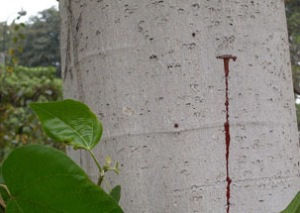
For 35 years of the rubber boom, the Indians were exploited, abused, murdered, enslaved and forced into prostitution. Meanwhile, the British take illegally seeds of Hevea (rubber tree) for planting in Indonesia, Ceylon and sub-Saharan Africa, improving profitability, reducing production costs and will end the monopoly of South America in 1915. The word "caoutchouc" comes from the Quechua cao which means "wood" and tchu "crying".
In 1915 began the decline of the cities of the Amazon rainforest quickly falling into poverty and isolation. Since the 40s began the exploitation of oil and wood, today still the main economic source of the Amazon rainforest.
Unusual Peru













